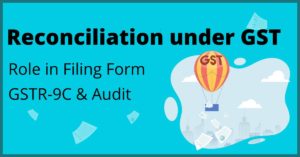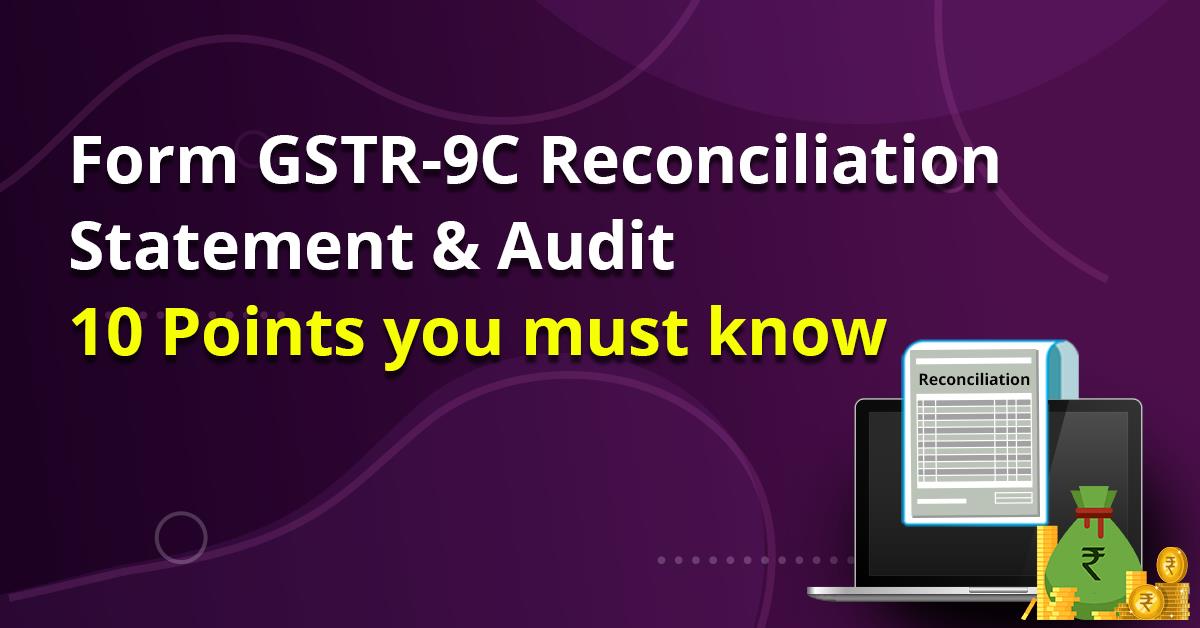Reconciliation under GST- 11 Essential Points to note before the Annual GST Audit!
Form GSTR-9C is one of the two annual return forms that businesses with a turnover of more than Rs. 2 Crores need to file at the end of each financial year.
Although the dates of filing this return have extended over the past few years but taxpayers will have to file it eventually, more sooner than later.
These annual return forms are significant as they are the summary returns of all the transactions & business activities done in the entire year.
But also because these are the final declarations and cannot be amended since there is no provision yet to amend the annual return forms.
You can also file form GSTR-9C using GST Return Filing Software
In this article, we will talk about Form GSTR-9C & the role of reconciliation in filing the form. We will also address a few points you must note while or before filing the form GSTR-9C
What is Form GSTR-9C
Form GSTR-9C is an annual return reconciliation form that all taxpayers having an annual aggregate turnover of more than Rs. 2 Crores need to form.
Form GSTR-9C is the reconciliation statement between Form GSTR-9 form & the audited account statement of your business. Any mismatch or differences occurring during the reconciliation activity will have to be justified with reasons by the taxpayer in the form itself.
It is clear from the above explanation that the government’s motive here is transparency & clarity. GSTR-9C will throw light on any differences in- what has been declared in the returns all year long and what has been accounted in your records.
While filing the form an audit of all your business accounts by a professional CA or Cost Accountant is required mandatory. And further off a certificate of audit or Audit report must also be furnished along with Form GSTR-9C.
GSTR-9C is filed on a GSTIN level & not PAN level, so there can be multiple GSTR-9C Forms for one PAN.
The taxpayers will have to release any balance tax liability that arises upon the reconciliation through Form DRC-03, which is available on the GST Portal.
GSTR-9C Format & structure
Form GSTR-9C comprises of two parts, Part A: the reconciliation Statement, which is again divided in 5 Tables & Part B: Certification, which is a certificate declaration filed & signed by a CA or a Cost Accountant.
Let us look into each Part & tables one by one-
Part A: Reconciliation Statement
Part- I Basic Details
In this part, you need to fill, the Financial Year, GSTIN, Legal Name, Trade Name, & Turnover (to see if you are liable to audit)
Part-II Reconciliation of turnover declared in audited Annual Financial Statement with turnover declared in Annual Return (GSTR9)
- Table 5 (A-R) Reconciliation of Gross Turnover
- Table 6 (A-C) Reasons for Un-Reconciled difference in Annual Gross Turnover
- Table 7 (A-G) Reconciliation of Taxable Turnover
- Table 8 (A-C) Reasons for Un-Reconciled difference in taxable turnover
Part-III Reconciliation of tax paid
- Table 9 (A-R) Reconciliation of rate wise liability and amount payable thereon
- Table 10 (A-C) Reasons for un-reconciled payment of amount
- Table 11 Additional amount payable but not paid (due to reasons specified under Tables 6,8 and 10 above)
Part-IV Reconciliation of Input Tax Credit (ITC)
- Table 12 (A-F) Reconciliation of Net Input Tax Credit (ITC)
- Table 13 (A-C) Reasons for un-reconciled difference in ITC
- Table 14 (A-T) Reconciliation of ITC declared in Annual Return (GSTR9) with ITC availed on expenses as per audited Annual Financial Statement or books of account
- Table 15 (A-C) Reasons for un-reconciled difference in ITC
- Table 16 Tax payable on un-reconciled difference in ITC (due to reasons specified in 13 and 15 above)
Part-V Auditor’s recommendation on additional Liability due to non-reconciliation
Part B: Certification
To be filled & signed by the Auditor or a CA and filed by the taxpayer along with the reconciliation statement.
The significant role of reconciliation in GSTR-9C
Reconciliation from a very micro-level is required to acquire a perfect & accurate GSTR-9C filing & audit. Reconciliation of older returns plays a vital role while reconciling all the returns throughout the year, you can take help from reconciliation software to manage & carry out accurate reconciliation.
Form GSTR-9 is nothing but the compilation of forms GSTR-1, GSTR-3B, & GSTR-2A from the entire year. Any mismatches or discrepancies in any of these forms from any month of the year can cause a misbalance & mismatch in the form GSTR-9 which will directly affect the audit.
Form GSTR-9C in nothing but the reconciliation statement between what you have filed in your annual return & what you have declared or mentioned in your personal books of accounts.
Both the above must match & that is how the Government will have full transparency of whether you are a regular & righteous tax-filer or not. It clears up your business with respect to taxes, in the eyes of the Government.
Hence reconciliation on a monthly basis is a highly recommended & clever idea for businesses & accountants. This will help you in keeping your accounts & returns neat & organized & will ensure accuracy in the annual reconciliation.
Another important task for taxpayers, businesses, & accountants can be data preparation, it is very important to store & maintain the reports of the various returns & transactions throughout the year.
These reports can serve as a great & simple option to reconcile the annual returns easily.
GSTHero can help your business with both of these tasks & more so that you can stay assured that your annual return filings & audits shall be error-free & organized.
GSTHero provides solutions to file GST returns (GSTR-1, GSTR-2A (reconciliation), GSTR-3B, GSTR-9 & GSTR-9C), extract & maintain various important reports, & Advanced reconciliation. These 3 major tools are guaranteed to make your monthly as well as annual filing & reconciliation better, more accurate, & more organized, in minimal efforts & time consumption.
11 Major Points to note before filing the form GSTR-9C

By now, you know the meaning of Form GSTR-9C, it’s objective & format.
In this final section, we are going to shed some light on some highly important aspects that you must consider before filing form GSTR-9C and conducting the audit of the accounts of your Business.
So we have analyzed & stated down for you 10 most important things to consider before filing GSTR-9C & audit-
- Reconciliation and Tallying the accounts-returns monthly- Before auditing the accounts & filing the annual returns it is important to reconcile the accounts & the returns on a micro-level. This will help you & your business immensely to make the annual audits error & mismatch-free. Since you already reconcile the GSTR-2A with your purchase records to calculate ITC, you only need to reconcile the GSTR-3B & GSTR-1 with your accounts. When any changes are made in the transaction ensure to make the changes to the accounts as well as your returns.
- Maintenance of Reports and Documents- Be very careful while dealing with documents especially when the volume is high it may be overwhelming to handle the documents. For this, you can have a system set-up dedicated just to the documents. There may be multiple documents behind a transaction, challans, credit notes, debit notes, invoices, other applications & forms, etc. But these documents cannot be neglected if you are willing to achieve accuracy in audits & reconciliation. Apart from the documents, you must also focus on maintaining the various reports & excels of transactions that you carry out, this too ou can do on a monthly basis to avoid confusion.
- Tax Liability Calculation- While you calculate the tax liabilities, make sure to keep in mind, the tax type (CGST, SGST, IGST, UTGST), the tax rate slab (%), the changes in the rate (if any), HSN-wise classification of goods, and the supply type, (zero-rated, nil-rated, exempt, exports, RCM, etc.)
- ITC availment- ITC availment & calculation every month, plays a vital role in the annual Audit & Reconciliation of the returns with the accounts, your monthly reconciliation must be accurate & organized. Make sure to claim only the eligible credits, & reverse the ineligible credits if you have already claimed. You can take help from GST Suvidha Provider such as GSTHero to manage & avail correct and maximum ITC.
- Reverse Charge Mechanism- Focusing on the inward supplies liable to reverse charge, since it has the self-declaration type of invoices, preserving the documents for annual returns & accurately declaring them in the monthly returns is important. Also, there are many provisions under RCM that you need to understand & comply with, for example, you cannot adjust the tax under RCM with ITC. You must release the tax in cash & then you can claim the ITC on it.
- Other Income Header- While filing the annual returns pay special attention to the other income header, ensure that you have released all the tax liabilities. There can be various types of other incomes that a business can have & each of them may levy different types of GST. Clear all the penalties, late-fees, interests, etc. to keep the accounts clear.
- Compliance with the 180 Days payment rule- a taxpayer as both supplier & recipient, must comply with Section 16(2) of the CGST Act, 2017, that requires you to make payment against the invoice within 180 days from the date of generation on the invoice.
- Sales & purchases of Assets and Capital Goods- The sales & purchases of assets & capital goods also fall under the GST roof, hence these transactions should also be considered while filing returns & auditing the accounts.
- The entry of Transitional Credits- Even though it has been a while since the implementation of the GST regime, transitional credit issues still pertain, & need to be considered very carefully while filing returns & auditing.
- Management of GST Refunds- For businesses dealing with exports or any other transactions where they are eligible for refunds, must account the refunds carefully, & maintain their supporting documents for internal as well as for annual audits. Organized accounting & calculation of these refunds is
- Turnover, Income, Tax paid/payable, ITC availed- The reconciliation statement requires the matching if turnovers, income amount/Taxable amount, Tax paid/payable & ITC availed. Focus on these aspects primarily before the audit & before filing GSTR-9C
Conclusion
The annual accounts audit & reconciliation of the GSTR-9 with accounts have only one objective- transparency to avoid the tax leakage & clear what taxpayers are actually earning, what they are disclosing, what tax amount they are paying & what amount of ITC they have claimed.
Taxpayers must focus on reconciling their GSTRs monthly rather than compiling them.
Even if the year has ended & you have to reconcile & audit now you can take help from GSPS & software solution providers such as GSTHero, which will help you in filing the returns & in auditing.
With GSTHero, you can save your time & most of all the efforts that this tedious task of reconciliation & audit requires. You can enhance your productivity, & accuracy in the tasks that you are performing.
About the Author– GSTHero– Making GST Simple! GSTHero is the best GST filing, e-Way Bill Generation & E Invoicing Software in India. GSTHero is a government authorized GST Suvidha Provider. Both Businesses and Tax Practitioners can file GSTR 1, GSTR 3B, GSTR 9 and GSTR 9C with all supporting reports. 1 Click Auto Reconciliation & report-matching feature helps you in claiming up to 100% ITC and finds your GST Defaulting Suppliers. GSTR2A vs GSTR-3B, GSTR-1 vs GSTR-3B, ‘GSTR-1, GSTR-2A & GSTR-3B’ annual report matching is also provided by GSTHero.
GSTHero ERP Plugins provide 1 Click e-Way Bill & E-Invoice, Generation, Operation & Printing from your own ERP like Tally, SAP, Marg, Busy, Microsoft Dynamics, Oracle & others itself with high data security


